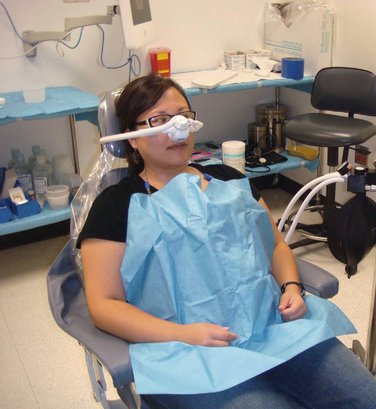chapter 12 Inhalation Sedation: Rationale
The technique of inhalation sedation with nitrous oxide (N2O) and oxygen (O2) possesses many significant advantages over other techniques of pharmacosedation. Inhalation sedation represents the most nearly “ideal” clinical sedative circumstance. This chapter discusses and demonstrates the indications for use of N2O-O2 in dentistry and other constantly expanding branches of medicine (Figure 12-1).
ADVANTAGES
| Oral | Fixed duration of action, approximately 2 to 3 hr |
| Rectal | Fixed duration of action, approximately 2 to 3 hr |
| IM, IN | Fixed duration of action, approximately 2 to 4 hr, with significant variation by drug |
| IV | Fixed duration of action, with significant variation by drug Diazepam, midazolam, 45 min Promethazine, 90 min Pentobarbital, 2 to 4 hr |
| Inhalation | Duration variable, at discretion of administrator |
| Oral | Recovery not entirely complete even after 2 to 3 hr |
| Rectal | Recovery not entirely complete even after 2 to 3 hr |
| IM, IN | Recovery not entirely complete even after 2 to 3 hr |
| IV | Recovery not entirely complete even after 2 to 3 hr |
| Inhalation | Recovery usually complete following 3 to 5 min of inhalation of 100% O2 |
| Oral | Recovery not complete; patient always requires escort |
| Rectal | Recovery not complete; as usually used in pediatric dentistry, patient will be escorted by parent or guardian |
| IM, IN | Recovery not complete; patient always requires escort |
| IV | Recovery not complete; patient always requires escort |
| Inhalation | Recovery almost always complete; patient usually may be discharged from office alone, with no admonitions about activities |
Disadvantages
The following are disadvantages associated with N2O-O2 inhalation sedation.
INDICATIONS
The primary indications for the use of inhalation sedation are the same as those for other sedative techniques: the management of fear and anxiety, the medically compromised patient, and the management of gagging.5 Over and above these usual indications, N2O-O2 is readily controllable; this permits its use for aspects of dental care in which the use of moderate sedation might not usually be considered.
Stay updated, free dental videos. Join our Telegram channel

VIDEdental - Online dental courses



